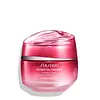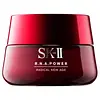What's inside
What's inside
 Key Ingredients
Key Ingredients

 Benefits
Benefits

 Concerns
Concerns

 Ingredients Side-by-side
Ingredients Side-by-side

Water
Skin ConditioningDipropylene Glycol
HumectantGlycerin
HumectantBetaine
HumectantAlcohol Denat.
AntimicrobialDimethicone
EmollientIsodecyl Neopentanoate
EmollientPPG-3 Dipivalate
Skin ConditioningXylitol
HumectantPhytosteryl/Octyldodecyl Lauroyl Glutamate
Skin ConditioningPhenoxyethanol
PreservativeHdi/Trimethylol Hexyllactone Crosspolymer
Ammonium Acryloyldimethyltaurate/Beheneth-25 Methacrylate Crosspolymer
Emulsion StabilisingCarbomer
Emulsion StabilisingAlcohol
AntimicrobialPotassium Hydroxide
BufferingErythritol
HumectantPEG/PPG-14/7 Dimethyl Ether
Skin ConditioningPEG/PPG-17/4 Dimethyl Ether
Skin ConditioningTocopheryl Acetate
AntioxidantParfum
MaskingButylene Glycol
HumectantXanthan Gum
EmulsifyingDisodium EDTA
Acrylates/C10-30 Alkyl Acrylate Crosspolymer
Emulsion StabilisingAminopropyl Dimethicone
Caffeine
Skin ConditioningTremella Fuciformis Polysaccharide
Emulsion StabilisingSilica
AbrasiveSodium Metaphosphate
BufferingHexyl Cinnamal
PerfumingTocopherol
AntioxidantLimonene
PerfumingLinalool
PerfumingSodium Metabisulfite
AntioxidantCitronellol
PerfumingScutellaria Baicalensis Root Extract
AstringentAngelica Keiskei Leaf/Stem Extract
Skin ConditioningGeraniol
PerfumingCamellia Sinensis Leaf Extract
AntimicrobialSodium Acetylated Hyaluronate
HumectantCI 77491
Cosmetic ColorantCitrus Unshiu Peel Extract
MaskingZingiber Aromaticus Extract
Skin ConditioningHydrolyzed Conchiolin Protein
Skin ConditioningCinnamomum Cassia Bark Extract
MaskingPyrola Incarnata Extract
Skin ConditioningPanax Ginseng Root Extract
EmollientWater, Dipropylene Glycol, Glycerin, Betaine, Alcohol Denat., Dimethicone, Isodecyl Neopentanoate, PPG-3 Dipivalate, Xylitol, Phytosteryl/Octyldodecyl Lauroyl Glutamate, Phenoxyethanol, Hdi/Trimethylol Hexyllactone Crosspolymer, Ammonium Acryloyldimethyltaurate/Beheneth-25 Methacrylate Crosspolymer, Carbomer, Alcohol, Potassium Hydroxide, Erythritol, PEG/PPG-14/7 Dimethyl Ether, PEG/PPG-17/4 Dimethyl Ether, Tocopheryl Acetate, Parfum, Butylene Glycol, Xanthan Gum, Disodium EDTA, Acrylates/C10-30 Alkyl Acrylate Crosspolymer, Aminopropyl Dimethicone, Caffeine, Tremella Fuciformis Polysaccharide, Silica, Sodium Metaphosphate, Hexyl Cinnamal, Tocopherol, Limonene, Linalool, Sodium Metabisulfite, Citronellol, Scutellaria Baicalensis Root Extract, Angelica Keiskei Leaf/Stem Extract, Geraniol, Camellia Sinensis Leaf Extract, Sodium Acetylated Hyaluronate, CI 77491, Citrus Unshiu Peel Extract, Zingiber Aromaticus Extract, Hydrolyzed Conchiolin Protein, Cinnamomum Cassia Bark Extract, Pyrola Incarnata Extract, Panax Ginseng Root Extract
Water
Skin ConditioningGlycerin
HumectantGalactomyces Ferment Filtrate
HumectantIsohexadecane
EmollientNiacinamide
SmoothingIsopropyl Isostearate
EmollientButylene Glycol
HumectantButyrospermum Parkii Butter
Skin ConditioningCaprylic/Capric Triglyceride
MaskingPentylene Glycol
Skin ConditioningDimethicone
EmollientPhytosteryl/Behenyl/Octyldodecyl Lauroyl Glutamate
Skin ConditioningVinyl Dimethicone/Methicone Silsesquioxane Crosspolymer
Stearyl Alcohol
EmollientSodium Acrylate/Sodium Acryloyldimethyl Taurate Copolymer
Emulsion StabilisingCetyl Alcohol
EmollientBehenyl Alcohol
EmollientPanthenol
Skin ConditioningTocopheryl Acetate
AntioxidantBenzyl Alcohol
PerfumingDimethiconol
EmollientCetearyl Alcohol
EmollientCetearyl Glucoside
EmulsifyingMethylparaben
PreservativePEG-100 Stearate
Polymethylsilsesquioxane
Polysorbate 80
EmulsifyingStearic Acid
CleansingDisodium EDTA
Propylparaben
PreservativeSodium PEG-7 Olive Oil Carboxylate
EmulsifyingEthylparaben
PreservativeSorbitan Oleate
EmulsifyingChlorella Vulgaris Extract
Skin ConditioningPEG-7 Glyceryl Cocoate
EmulsifyingSodium Hydroxide
BufferingParfum
MaskingAcanthopanax Senticosus Root Extract
Skin ConditioningHydrolyzed Soy Protein
HumectantCynara Scolymus Leaf Extract
Skin ConditioningPolyquaternium-7
Hydrolyzed Yeast Protein
Skin ConditioningPalmitoyl Pentapeptide-4
Skin ConditioningMethylsilanol Tri-PEG-8 Glyceryl Cocoate
EmulsifyingMethicone
EmollientCI 77891
Cosmetic ColorantCI 77492
Cosmetic ColorantWater, Glycerin, Galactomyces Ferment Filtrate, Isohexadecane, Niacinamide, Isopropyl Isostearate, Butylene Glycol, Butyrospermum Parkii Butter, Caprylic/Capric Triglyceride, Pentylene Glycol, Dimethicone, Phytosteryl/Behenyl/Octyldodecyl Lauroyl Glutamate, Vinyl Dimethicone/Methicone Silsesquioxane Crosspolymer, Stearyl Alcohol, Sodium Acrylate/Sodium Acryloyldimethyl Taurate Copolymer, Cetyl Alcohol, Behenyl Alcohol, Panthenol, Tocopheryl Acetate, Benzyl Alcohol, Dimethiconol, Cetearyl Alcohol, Cetearyl Glucoside, Methylparaben, PEG-100 Stearate, Polymethylsilsesquioxane, Polysorbate 80, Stearic Acid, Disodium EDTA, Propylparaben, Sodium PEG-7 Olive Oil Carboxylate, Ethylparaben, Sorbitan Oleate, Chlorella Vulgaris Extract, PEG-7 Glyceryl Cocoate, Sodium Hydroxide, Parfum, Acanthopanax Senticosus Root Extract, Hydrolyzed Soy Protein, Cynara Scolymus Leaf Extract, Polyquaternium-7, Hydrolyzed Yeast Protein, Palmitoyl Pentapeptide-4, Methylsilanol Tri-PEG-8 Glyceryl Cocoate, Methicone, CI 77891, CI 77492
 Reviews
Reviews

Ingredients Explained
These ingredients are found in both products.
Ingredients higher up in an ingredient list are typically present in a larger amount.
Butylene Glycol (or BG) is used within cosmetic products for a few different reasons:
Overall, Butylene Glycol is a safe and well-rounded ingredient that works well with other ingredients.
Though this ingredient works well with most skin types, some people with sensitive skin may experience a reaction such as allergic rashes, closed comedones, or itchiness.
Learn more about Butylene GlycolDimethicone is a type of synthetic silicone created from natural materials such as quartz.
What it does:
Dimethicone comes in different viscosities:
Depending on the viscosity, dimethicone has different properties.
Ingredients lists don't always show which type is used, so we recommend reaching out to the brand if you have questions about the viscosity.
This ingredient is unlikely to cause irritation because it does not get absorbed into skin. However, people with silicone allergies should be careful about using this ingredient.
Note: Dimethicone may contribute to pilling. This is because it is not oil or water soluble, so pilling may occur when layered with products. When mixed with heavy oils in a formula, the outcome is also quite greasy.
Learn more about DimethiconeDisodium EDTA plays a role in making products more stable by aiding other preservatives.
It is a chelating agent, meaning it neutralizes metal ions that may be found in a product.
Disodium EDTA is a salt of edetic acid and is found to be safe in cosmetic ingredients.
Learn more about Disodium EDTAGlycerin is already naturally found in your skin. It helps moisturize and protect your skin.
A study from 2016 found glycerin to be more effective as a humectant than AHAs and hyaluronic acid.
As a humectant, it helps the skin stay hydrated by pulling moisture to your skin. The low molecular weight of glycerin allows it to pull moisture into the deeper layers of your skin.
Hydrated skin improves your skin barrier; Your skin barrier helps protect against irritants and bacteria.
Glycerin has also been found to have antimicrobial and antiviral properties. Due to these properties, glycerin is often used in wound and burn treatments.
In cosmetics, glycerin is usually derived from plants such as soybean or palm. However, it can also be sourced from animals, such as tallow or animal fat.
This ingredient is organic, colorless, odorless, and non-toxic.
Glycerin is the name for this ingredient in American English. British English uses Glycerol/Glycerine.
Learn more about GlycerinParfum is a catch-all term for an ingredient or more that is used to give a scent to products.
Also called "fragrance", this ingredient can be a blend of hundreds of chemicals or plant oils. This means every product with "fragrance" or "parfum" in the ingredients list is a different mixture.
For instance, Habanolide is a proprietary trade name for a specific aroma chemical. When used as a fragrance ingredient in cosmetics, most aroma chemicals fall under the broad labeling category of “FRAGRANCE” or “PARFUM” according to EU and US regulations.
The term 'parfum' or 'fragrance' is not regulated in many countries. In many cases, it is up to the brand to define this term.
For instance, many brands choose to label themselves as "fragrance-free" because they are not using synthetic fragrances. However, their products may still contain ingredients such as essential oils that are considered a fragrance by INCI standards.
One example is Calendula flower extract. Calendula is an essential oil that still imparts a scent or 'fragrance'.
Depending on the blend, the ingredients in the mixture can cause allergies and sensitivities on the skin. Some ingredients that are known EU allergens include linalool and citronellol.
Parfum can also be used to mask or cover an unpleasant scent.
The bottom line is: not all fragrances/parfum/ingredients are created equally. If you are worried about fragrances, we recommend taking a closer look at an ingredient. And of course, we always recommend speaking with a professional.
Learn more about ParfumTocopheryl Acetate is AKA Vitamin E. It is an antioxidant and protects your skin from free radicals. Free radicals damage the skin by breaking down collagen.
One study found using Tocopheryl Acetate with Vitamin C decreased the number of sunburned cells.
Tocopheryl Acetate is commonly found in both skincare and dietary supplements.
Learn more about Tocopheryl AcetateWater. It's the most common cosmetic ingredient of all. You'll usually see it at the top of ingredient lists, meaning that it makes up the largest part of the product.
So why is it so popular? Water most often acts as a solvent - this means that it helps dissolve other ingredients into the formulation.
You'll also recognize water as that liquid we all need to stay alive. If you see this, drink a glass of water. Stay hydrated!
Learn more about Water